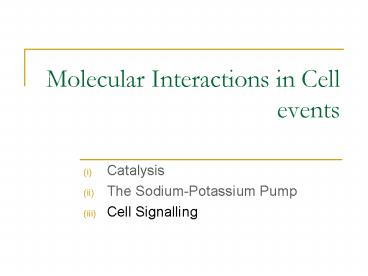Molecular Interactions in Cell events - PowerPoint PPT Presentation
1 / 17
Title:
Molecular Interactions in Cell events
Description:
Molecular Interactions in Cell events Catalysis The Sodium-Potassium Pump Cell Signalling – PowerPoint PPT presentation
Number of Views:112
Avg rating:3.0/5.0
Title: Molecular Interactions in Cell events
1
Molecular Interactions in Cell events
- Catalysis
- The Sodium-Potassium Pump
- Cell Signalling
2
Alien Invasion
- Alien customs
- What does this have to do with cell signalling?
Gesture Meaning
Smile A sign of violence or a threat
Wave Go away
Handshake Gesture of love
Being higher than the person Insult
Hello / how are you / welcome You smell
3
Cell Signalling general principles
- Communication is usually achieved through
hormones or nerve impulses - Signal is sent by a signalling cell
- Signal is received by a target cell
- Any change in signal type is called signal
transduction - A signal transduction pathway is a series of
responses to the bonding of a signal molecule - All receptor proteins have an active site. They
are specific to signal molecules. Therefore,
signals will only act on target cells that have
these receptors.
4
Extracellular hydrophobic signalling molecules
- Hydrophobic molecules can dissolve in the plasma
membrane and move into a cell by diffusion - Examples steroids e.g. testosterone
- Target cells have a specific hormone receptor
- The hormone binds and activates the receptor
- Hormone receptor complex binds to gene
regulatory sites - Stimulates the transcription of certain genes
5
Extracellular hydrophobic signalling molecules
6
Extracellular hydrophilic signalling molecules
- Have charged surfaces, therefore cannot dissolve
in cell membrane - Are too large to pass through protein channels
- Bind and change the shape of proteins on the
surface of the target cell - There are three types of receptor protein
- Ion-channel linked (chemically-gated ion
channels) - Enzyme linked
- G-protein linked
7
Extracellular hydrophilic signalling molecules
- Ion-gated channels
- Signal molecule binds
- Changes the shape of a protein channel, which
opens - Ions flow in through the open protein gate
- Example
- Nerve cells
- Neurotransmitters e.g. acetylcholine or
noradrenalin act as signal molecules - Opens ion gate to allow transmission of a message
from one neuron to another.
8
(No Transcript)
9
Extracellular hydrophilic signalling molecules
- Enzyme-linked receptors
- A receptor-enzyme complex spans the membrane,
with the enzyme on the inside - The enzyme is inactive
- The signal molecule binds to the receptor, which
then activates the enzyme
10
Extracellular hydrophilic signalling molecules
- Enzyme linked receptors
- Example
- Tyrosine-Kinase receptor
- Signal molecules are insulin and growth hormone
(both peptide hormones) - Activates the complex and kinase activates other
enzymes through phosphorylation - Ultimately gene regulation proteins are switched
on resulting in different gene transcription
11
(No Transcript)
12
(No Transcript)
13
Extracellular hydrophilic signalling molecules
- G-protein linked receptors
- Receptor molecule spans the membrane, with a
G-protein attached on the inside - Signal molecule binds to the receptor and causes
a molecule called GTP to activate the G-protein - The activated G-protein moves along the plasma
membrane and activates an enzyme (or sometimes an
ion channel protein)
14
Extracellular hydrophilic signalling molecules
- G-protein linked receptors
- Example
- Signal molecules can include glucagon and
adrenaline (both peptide hormones) - After G-protein and enzyme are activated the
enzyme releases second messenger molecules (e.g.
cyclic AMP or Ca2) - Second messengers phosphorylate and activate
kinase enzymes - These activate more kinase enzymes
- With glucagon, the final set of kinase enzymes
activated convert glycogen to glucose-1-phosphate
15
(No Transcript)
16
Summary
17
Learning Activities
- Read DART pg 70 72
- Scholar 7.2 7.3 (7.1 to a lesser extent)
- Advanced Higher Questions
- Draw a diagram / make a poster to explain the
steps in extracellular hydrophobic signalling - Draw flow charts to show the processes in
extracellular hydrophilic signalling - Revise the biology behind each of the examples
given - http//www.sp.uconn.edu/bi107vc/images/anim/Sigtr
anRA.gif - Do your own internet search to find info.
Remember to evaluate the site Who is the
author? Who are the intended audience? When was
it last updated?































